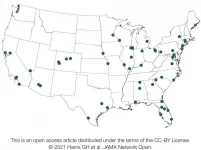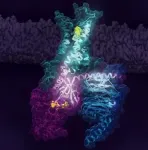(Press-News.org) During a public health crisis like the COVID-19 pandemic, U.S. hospitals need to allocate scarce medical resources in an equitable manner, according to clinicians and ethicists at the University of Miami Miller School of Medicine.
"Significant concerns have been raised that crisis standards of care may be biased against certain patients based on race or ethnicity," said Hayley Gershengorn, M.D., associate professor of pulmonary and critical care medicine. "To examine that issue, we analyzed over a thousand medical records from two academic hospitals where University of Miami faculty see patients and found no disparities in how our crisis standards of care policy prioritizes patients."
Dr. Gershengorn was the lead author of the study, "Assessment of the Disparities Associated With a Crisis Standards of Care Resource Allocation Algorithm for Patients in Two U.S. Hospitals During the COVID-19 Pandemic," published March 11 in JAMA Network Open, a journal of the American Medical Association.
"Early in the pandemic, we became concerned that demand for hospital resources such as ventilators would be greater than availability," she said. "A crisis policy can help physicians allocate resources in such circumstances."
To address those ethical issues, a Miller School team developed a Crisis Standards of Care policy that was approved by the university and now serves as a model for other members of the Florida Hospital Association, said Dr. Gershengorn. "After approving the policy, we felt it was also important to see how well the policy could be put into practice," she added.
The critical care faculty recruited third-year Miller School students to go through the medical records daily and calculate priorities based on the sequential organ failure assessment (SOFA) score, which measures patient acuity, and comorbidity burden. "This study would not have been possible without our students," said Dr. Gershengorn. "They did an amazing job."
The new study asked the question: Is there an association of race or ethnicity with priority scores used for resource allocation under our institution's crisis standards of care policy? The researchers looked at 1,127 adult patients (with 5,613 patient-days of data) who were admitted to one of the COVID-19 wards or were in a monitored unit requiring invasive or noninvasive ventilation or high-flow nasal cannula between May 26 and July 14, 2020.
"We found the priority score did not appear to discriminate against hospitalized patients based on self-identified Black race or Hispanic ethnicity," said Dr. Gershengorn.
Co-author Kenneth W. Goodman, Ph.D., director of the University of Miami Institute for Bioethics and Health Policy, said, "In a time of too much bad news, these results are very good news. We found that our resource allocation protocol would - if activated - not worsen existing inequities for Black and Hispanic populations when it comes to COVID-19."
Another co-author, Jeffrey P. Brosco, M.D., Ph.D., professor of pediatrics and the Institute's director of population health ethics, added, "We need to redouble our efforts to improve health equity, and one way is for health care providers to use data as we did to examine the effects of our policies and procedures."
Other Miller School co-authors included Gregory E. Holt, M.D., Ph.D., assistant professor of medicine; Joseph West, Sc.M., Sc.D. , voluntary assistant professor of public health science; Daniel H. Kett, M.D., professor of clinical medicine and associate chief medical officer for critical care at the University of Miami Hospital, as well as Miller School students Andrew Rezk, Stefanie Delgado, Nayna Shah, Arshia Arora, Leah B. Colucci, MS, Belen Mora, Rahul S. Iyengar, MHA, Andy Lopez, and Bianca M. Martinez.
Rezk, M.D. Candidate, Class of 2021, organized the data collection at the two academic hospitals with other students. "What I learned in this study is the importance of not just being aware of unintended health disparities but actively acknowledging them because these are life or death decisions that can affect an entire race or ethnicity," he said.
Another member of the Class of 2021, Delgado contributed to generating a protocol for the study, as well as training and supervising medical student volunteers. "The importance of acknowledging and addressing health disparities is imperative if we are to practice effective and equitable healthcare to all," she said. "The more we are aware of possible and existing disparities, the better prepared we are to identify and address associated obstacles which will ultimately lead to a better patient physician interaction and hopefully better health outcomes as well."
INFORMATION:
In-school COVID-19 transmission is rare - even among close school contacts of those who test positive for the virus - when schools heed public health precautions such as mandatory masking, social distancing and frequent hand-washing, according to results of a pilot study in Missouri aimed at identifying ways to keep elementary and secondary schools open and safe during the pandemic. A close contact is anyone who has been within 6 feet for more than 15 minutes in a 24-hour period with someone infected with COVID-19.
The study is part of a larger, ongoing collaboration involving the Centers for Disease Control and Prevention (CDC), Washington University School of Medicine in St. Louis, ...
LOS ALAMOS, N.M., March 19, 2021--Many machine learning algorithms on quantum computers suffer from the dreaded "barren plateau" of unsolvability, where they run into dead ends on optimization problems. This challenge had been relatively unstudied--until now. Rigorous theoretical work has established theorems that guarantee whether a given machine learning algorithm will work as it scales up on larger computers.
"The work solves a key problem of useability for quantum machine learning. We rigorously proved the conditions under which certain architectures of variational quantum algorithms will or will not have barren plateaus as they are scaled up," said Marco Cerezo, lead author on the paper published in Nature Communications ...
Notwithstanding last month's cold snap in Texas and Louisiana, climate change is leading to warmer winter weather throughout the southern U.S., creating a golden opportunity for many tropical plants and animals to move north, according to a new study appearing this week in the journal Global Change Biology.
Some of these species may be welcomed, such as sea turtles and the Florida manatee, which are expanding their ranges northward along the Atlantic Coast. Others, like the invasive Burmese python -- in the Florida Everglades, the largest measured 18 feet, end-to-end --maybe less so.
Equally unwelcome, and among the quickest to spread into warming areas, are ...
In light of recent extreme climate events--from wildfires blazing through the western US to snowstorms sweeping Texas into a blackout--climate scientists and media outlets have repeatedly called out the urgency of tackling the climate crisis. But in a new study published March 19 in the journal One Earth, researchers found that emphasizing urgency alone is not enough to kindle public support for climate change policies.
"We had the impression that policymakers shy away from enacting ambitious, stringent climate policy because they're afraid of ...
IIASA researchers worked with local stakeholders from the East African Community to explore and co-develop regional water scenarios that can enhance understanding of the up- and downstream water sector interactions in the extended Lake Victoria Basin to facilitate rational water resource planning.
East Africa is the world's fastest growing region outside of Asia, with an estimated growth of 5% and above over the last decade. Part of this success can likely be attributed to the East Africa Vision 2050, which was launched in 2015 by the Heads of States of the East African Community (EAC) - an intergovernmental organization composed of six countries in the African Great Lakes ...
PITTSBURGH, March 19, 2021 - A University of Pittsburgh School of Medicine-led survey of dozens of surge capacity managers at hospitals nationwide captures the U.S. health care system's pandemic preparedness status in the months before the first COVID-19 cases were identified in China.
Published today in the journal JAMA Network Open, the investigation details the strain experienced by U.S. hospitals during the 2017-18 influenza season, which was marked by severe illness and the highest infectious disease-related hospitalization rates in at least a decade. At the time, pandemic planning ...
A new research study at the University of Chicago Medicine has found that when it comes to COVID-19, having vitamin D levels above those traditionally considered sufficient may lower the risk of infection, especially for Black people.
The study, published March 19 in JAMA Open Network, retrospectively examined the relationship between vitamin D levels and likelihood of testing positive for COVID-19. While levels of 30 ng/ml or more are usually considered "sufficient," the authors found that Black individuals who had levels of 30 to 40 ng/ml had a 2.64 times higher risk of testing ...
What The Study Did: This analysis examined how patients with multiple sclerosis who have COVID-19 fare and what patient and disease characteristics are associated with worse outcomes.
Authors: Amber Salter, Ph.D., of Washington University in St Louis, is the corresponding author.
To access the embargoed study: Visit our For The Media website at this link https://media.jamanetwork.com/
(doi:10.1001/jamaneurol.2021.0688)
Editor's Note: The article includes conflict of interest and funding/support disclosures. Please see the article for additional information, including other authors, author contributions and affiliations, conflict of interest and financial disclosures, ...
What The Study Did: Researchers examined if differences in vitamin D levels greater than levels traditionally considered sufficient (30 ng/mL) are associated with having test results positive for COVID-19 in White and in Black individuals.
Authors: David O. Meltzer, M.D., Ph.D., of the University of Chicago, is the corresponding author.
To access the embargoed study: Visit our For The Media website at this link https://media.jamanetwork.com/
(doi:10.1001/jamanetworkopen.2021.4117)
Editor's Note: The article includes funding/support disclosures. Please see the article ...
A multinational research team led by Dr. Adnan Sljoka (RIKEN), Prof. R. Scott Prosser (Univ. of Toronto) with collaborations with Dr. Duy Phuoc Tran and Prof. Akio Kitao (Tokyo Tech) and Prof. Roger K. Sunahara (Univ. of California San Diego) has carried out experimental and computational studies, revealing key steps associated with the activation of the human adenosine A2A receptor (A2AR). A2AR is a member of superfamily of receptors called G protein-coupled receptors (GPCRs) (major drug targets) which engage the G protein and initiates cell signaling. The research team discovered that A2AR is represented by at least two inactive conformations and three active conformations whose populations are dependent on ligands and activation ...





